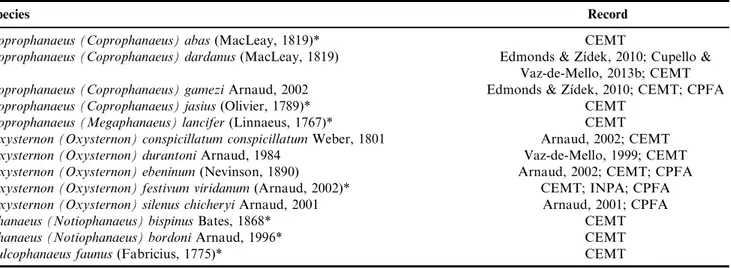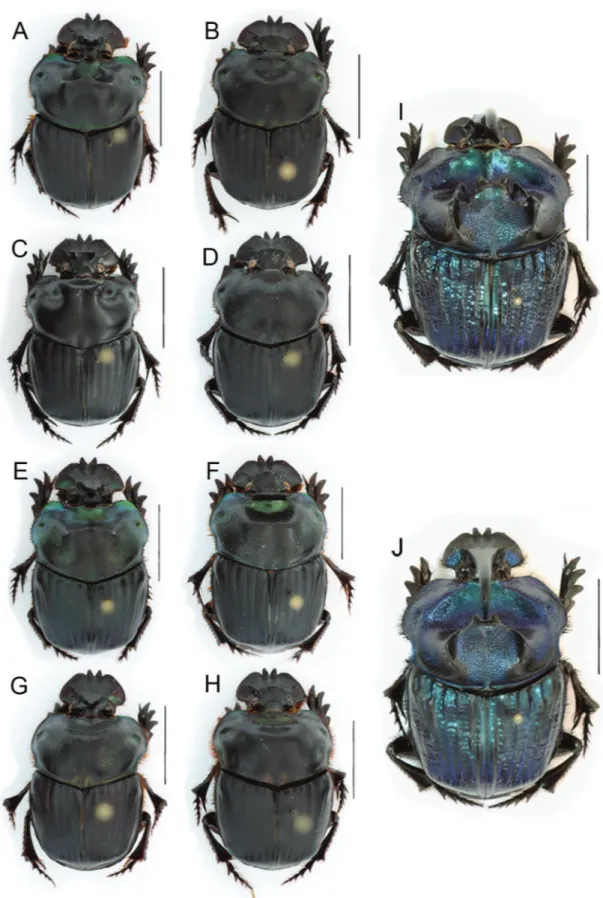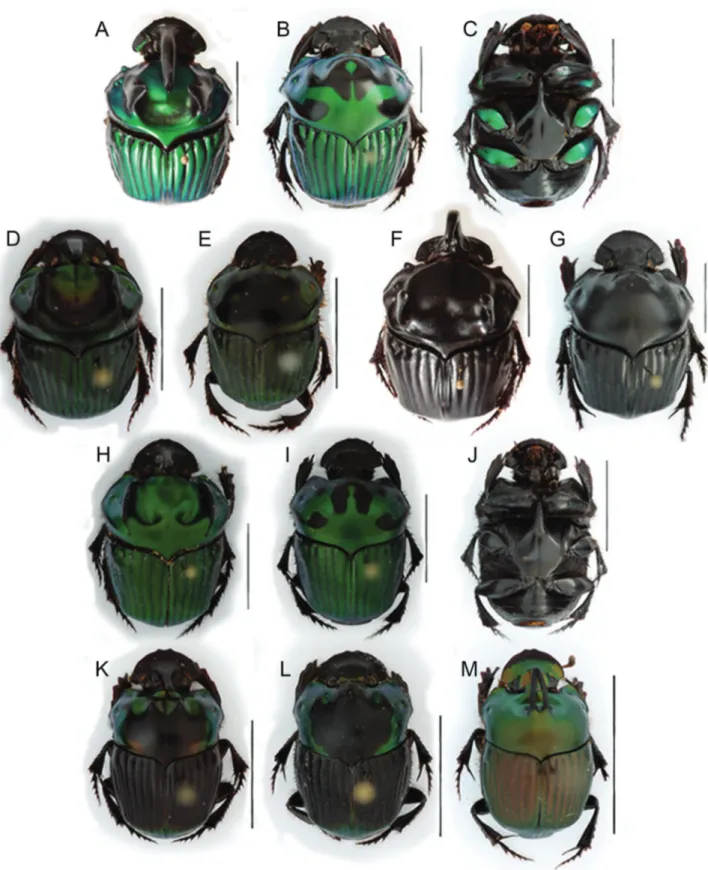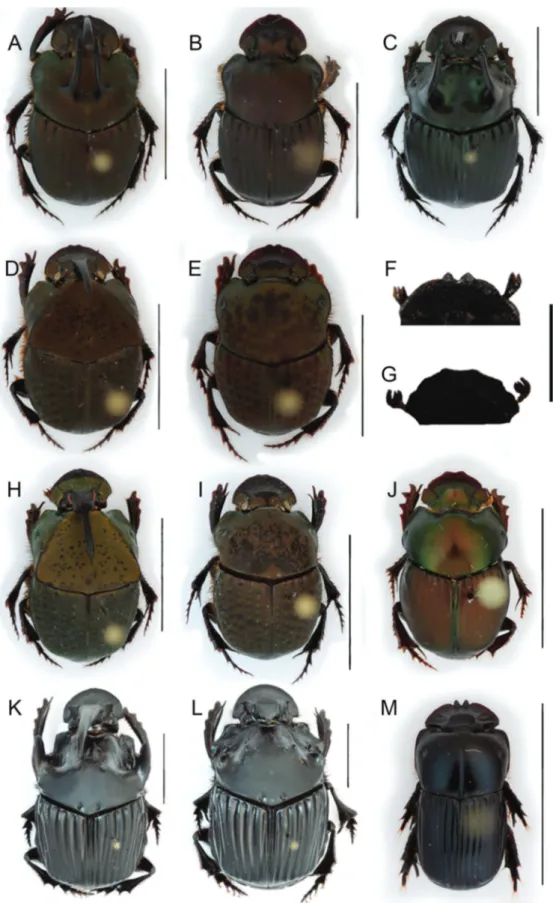article
Dung beetles of the tribe Phanaeini (Coleoptera: Scarabaeidade: Scarabaeinae) from
Roraima state, Northern Brazil: checklist and key to species
Thaynara L. Pacheco1,3& Fernando Z. Vaz-de-Mello2
1
Universidade Federal de Mato Grosso, Instituto de Biocieˆncias, Programa de Po´s-graduac¸a˜o em Zoologia, Av. Fernando Correa da Costa, 2367, Boa Esperanc¸a, Cuiaba´, MT, Brazil.
2
Universidade Federal de Mato Grosso, Instituto de Biocieˆncias, Departamento de Biologia e Zoologia, Av. Fernando Correa da Costa, 2637, Boa Esperanc¸a, Cuiaba´, MT, Brazil.
3
Corresponding author: Thaynara Lara Pacheco, e-mail:thay.lpacheco@gmail.com
PACHECO, T.L., VAZ-DE-MELLO, F.Z. Dung beetles of the tribe Phanaeini (Coleoptera:
Scarabaeidade: Scarabaeinae) from Roraima state, Northern Brazil: checklist and key to species. Biota http://dx.doi.org/10.1590/1676-06032015014514
Abstract: Phanaeini comprises about 160 species in 12 genera restricted to the Americas. Since the diversity of this tribe remains little known in several regions of Brazil, this study presents a guide to its 13 species with presence in the biologically rich and largely unexplored state of Roraima:Coprophanaeus (Coprophanaeus) abas (MacLeay, 1819),C. (C.) dardanus(MacLeay, 1819), C. (C.) gameziArnaud, 2002,C. (C.) jasius(Olivier, 1789),C. (Megaphanaeus) lancifer(Linnaeus, 1767),Oxysternon (Oxysternon) conspicillatum conspicillatumWerber, 1801,O. (O.) durantoniArnaud, 1984,O. (O.) ebeninum(Nevinson, 1890), O. (O.) festivum viridanum (Olsoufieff, 1924), O. (O.) silenus chicheryi Arnaud, 2001, Phanaeus (Notiophanaeus) bispinus Bates, 1868, P. (N.) bordoni Arnaud, 1996 (first record from Brazil), and
Sulcophanaeus faunus(Fabricius, 1775). The species ofDendropaemonwere not considered herein because the genus is presently under taxonomic revision.
Keywords: Inventory, Amazon, Guyana Shield.
PACHECO, T.L., VAZ-DE-MELLO, F.Z. Os besouros rola-bostas da tribo Phanaeini (Coleoptera: Scarabaeidae: Scarabaeinae) do estado de Roraima, Norte do Brasil: lista e chave para as espe´cies.Biota
http://dx.doi.org/10.1590/1676-06032015014514
Resumo:Phanaeini abrange cerca de 160 espe´cies pertencentes a 12 geˆneros restritos a`s Ame´ricas. Como a diversidade desta tribo permanece pouco conhecida em diversas regio˜es do Brasil, este estudo apresenta um guia de identificac¸a˜o das 13 espe´cies com registro de ocorreˆncia no estado biologicamente rico e amplamente inexplorado de Roraima: Coprophanaeus (Coprophanaeus) abas(MacLeay, 1819),
C. (C.) dardanus (MacLeay, 1819), C. (C.) gamezi Arnaud, 2002, C. (C.) jasius (Olivier, 1789),
C. (Megaphanaeus) lancifer (Linnaeus, 1767),Oxysternon (Oxysternon) conspicillatum conspicillatum
Werber, 1801,O. (O.) durantoniArnaud, 1984,O. (O.) ebeninum(Nevinson, 1890),O. (O.) festivum viridanum(Olsoufieff, 1924),O. (O.) silenus chicheryiArnaud, 2001,Phanaeus (Notiophanaeus) bispinus
Bates, 1868, P. (N.) bordoni Arnaud, 1996 (que aqui e´ reportado pela primeira vez no Brasil), e Sulcophanaeus faunus(Fabricius, 1775). As espe´cies do geˆnero Dendropaemon na˜o foram incluı´das no trabalho por estarem em processo de revisa˜o taxonoˆmica.
Palavras-chave: Inventa´rio, Amazoˆnia, Escudo das Guianas.
Introduction
Dung beetles of the subfamily Scarabaeinae are primarily scavengers that feed mostly on carrion, animal excrement and decomposing fruits (Halffter & Matthews 1966). Thus, such insects display a crucial role in the balance of several ecosystems, representing highly informative bioindicators regarding the conservation status of tropical environments (Halffter & Favila 1993). Such a peculiar feeding biology renders to dung beetles enormous ecological importance, acting directly in the fertilization and renewal of the soil, in the biological control of agricultural pests and also as secondary seed dispersal (Nicholset al.2008).
The tribe Phanaeini was introduced by Hope (1838) without further comments, and was defined in more details by Kolbe (1905) who, based on the cup-like shape of the antennal club and lack of protarsi, included in this group the following genera:
Phanaeus MacLeay, 1819, Oruscatus Bates, 1870, Gromphas
Brulle´, 1837, Bolbites Harold, 1868, DendropaemonPerty, 1830 andMegatharsisWaterhouse, 1891. Gillet (1911) added the genera
Ennearabdusvan Lansberge, 1874a andPleronyxvan Lansberge, 1874b (then spelledPteronyx) to Kolbe’s (1905) group, formally allocating it as a subtribe of Coprini. Thirteen years later, d’Olsoufieff (1924) removed Ennearabdus and Pteronyx (sic), included Diabroctis Gistel, 1857 (as its synonym Taurocopris Neotropica. 15(2): e20140145.
d’Olsoufieff, 1924),Oxysternon Castelnau, 1840 andTetramereia
Klages, 1907 (then described as new asBoucomontiusd’Olsoufieff, 1924). In addition, the same author splitted Phanaeus into five subgenera:Phanaeus, and the new taxaSulcophanaeus, Copropha-naeus,MetallophanaeusandMegaphanaeus. Based on the system proposed by d’Olsoufieff, Edmonds (1972) elevatedSulcophanaeus
andCoprophanaeusto genus level. Furthermore Edmonds (1972) described Mioxysternon as a subgenus of Oxysternon, and subgeneraParadendropaemonandCoprophanaeoidesfor the genus
Dendropaemon. More recently, Edmonds (1994) described Notio-phanaeusas a subgenus ofPhanaeusand Arnaud (2002) described
Pteroxysternonas a subgenus ofOxysternon.
Geographically restricted to the New World, the tribe Phanaeini includes around 160 species and 12 genera allocated in the subtribes Phanaeina and Gromphadina (Cupello & Vaz-de-Mello 2013). Phanaeini systematics is yet in discussion. In the field of alpha taxonomy, taxa of the group have been the subject of recent taxonomic revisions and of much discussion regarding validity of several species and subspecies (Arnaud 1996, 1996b, 1997, 2000, 2001, 2002, 2002b, 2002c, 2004, Edmonds 1994, Edmonds & Zı´dek 2004, 2010, 2012, Cupello & Vaz-de-Mello 2013, 2013b, Kohlmann & Solı´s 2012). Phyloge-netic studies are scarce and the debate regarding the identity of the tribe is still open. Zunino (1983, 1985) failed to recover Phanaeini as a clade, allocating its 12 genera to the tribe Onitini (Gromphadina [then spelled Gromphina] þ (Onitina þ Phanaeina)); in contrast, Philips et al. (2004) recovered a monophyletic Phanaeini supported by 14 morphological synapomorphies. One less inclusive approach by Price (2007) based on 67 morphological characters suggests that the genera
Phanaeus andOxysternon are not reciprocally monophyletic. Based on morphological and molecular data, Price (2009) recovers Phanaeus as polyphyletic, with representatives of
Coprophanaeus,Sulcophanaeus, and Oxysternonnested within its terminals. Finally Tarasov & Ge´nier (2015) recover Phanaeini as monophyletic with the genus Ennearabdus
appearing as its sister group forming Neotropical clade. The Brazilian state of Roraima lies on the Guiana Shield, northern South America. In terms of natural landscapes, Roraima is highly heterogeneous; while dense Amazonian forests predomi-nate in the southern portion of the state, open savannah spots
locally referred by ‘lavrados’ are common in central Roraima. In contrast, mountainous formations characterize the northern area of the state, where there is the Pacaraima range, the geographic divisor of the Amazonas and Orinoco basins. Such a geomor-phological plasticity is evidently associated to an enormous complexity of microhabitats, rendering Roraima a high biodiver-sity of animals and plants (IBGE 1977).
According to Vaz-de-Mello (2000), the diversity of dung beetles of Roraima is poorly known; considering all trust-worthy records, there are only 47 Scarabaeinae species documented in the state. Nonetheless, considering the ecolo-gical importance of the group, the knowledge on the scarab diversity and the availability of tools allowing precise identification of species are crucial to provide proper support to future studies of conservational concern. Herein we provide a detailed inventory of the Phanaeini species occurring in the limits of the Roraima state, presented as a checklist of species containing detailed geographic data, as well as a key to species and an illustrated guide.
Materials and Methods
We examined specimens from the following entomo-logical collections (acronyms in parentheses): Setor de Ento-mologia da Colec¸a˜o Zoolo´gica da Universidade Federal de Mato Grosso, Departamento de Biologia e Zoologia, Cuiaba´, Mato Grosso, Brasil (CEMT), Colec¸a˜o de Invertebrados do Instituto Nacional de Pesquisas da Amazoˆnia, Manaus, Amazonas, Brasil (INPA), and Patrick and Florent Arnaud private collection, Saintry sur Seine, France (CPFA). In addition, we performed an extensive investigation of the literature approaching South American Scarabaeine (species descriptions, taxonomic revisions and regional inventories) computing all trustworthy records attributed to Roraima localities.
Results and Discussion
We reported 13 species of the tribe Phanaeini from localities within the limits of the state of Roraima (Table 1), since the publication of the most recent studies making reference to
Table 1.Checklist of Phanaeini species known to occur in Roraima.
Species Record
Coprophanaeus (Coprophanaeus) abas(MacLeay, 1819)* CEMT
Coprophanaeus (Coprophanaeus) dardanus(MacLeay, 1819) Edmonds & Zı´dek, 2010; Cupello & Vaz-de-Mello, 2013b; CEMT
Coprophanaeus (Coprophanaeus) gameziArnaud, 2002 Edmonds & Zı´dek, 2010; CEMT; CPFA
Coprophanaeus (Coprophanaeus) jasius(Olivier, 1789)* CEMT
Coprophanaeus (Megaphanaeus) lancifer(Linnaeus, 1767)* CEMT
Oxysternon (Oxysternon) conspicillatum conspicillatumWeber, 1801 Arnaud, 2002; CEMT
Oxysternon (Oxysternon) durantoniArnaud, 1984 Vaz-de-Mello, 1999; CEMT
Oxysternon (Oxysternon) ebeninum(Nevinson, 1890) Arnaud, 2002; CEMT; CPFA
Oxysternon (Oxysternon) festivum viridanum(Arnaud, 2002)* CEMT; INPA; CPFA
Oxysternon (Oxysternon) silenus chicheryiArnaud, 2001 Arnaud, 2001; CPFA
Phanaeus (Notiophanaeus) bispinusBates, 1868* CEMT
Phanaeus (Notiophanaeus) bordoniArnaud, 1996* CEMT
Sulcophanaeus faunus(Fabricius, 1775)* CEMT
n
Roraima (Vaz-de-Mello 2000, Arnaud 2002, Edmonds & Zı´dek 2010, Cupello & Vaz-de-Mello 2013b).
Vaz-de-Mello (1999) mentionedOxysternon (O.) durantonias the first Phanaeini record to Roraima; two years later, Arnaud (2001) describedO. (O.) silenus chicheryifrom the confluence of the rivers Negro and Branco. Arnaud (2002) added O. (O.) conspicillatum conspicillatum, O. (O.) ebeninumand O. (Miox-ysternon) spiniferum spiniferum as state records; however, the latter record is an error due to confusion of the abbreviations of the states Rondoˆnia (RO) and Roraima (RR) (FZVM, personal observation in CPFA). In a taxonomic revision ofOxysternon, Edmonds & Zı´dek (2004) synonymizedO. festivum festivumand
O. f. viridanummentioning one specimen from Roraima. In the same year, Arnaud (2004) resurrected O. f. viridanum. After examining specimens from the same localities that based Edmond & Zı´dek’s (2004) decisions, we concluded that their record of Roraima shall be attributed to O. f. viridanum (sensu Arnaud, 2004). Edmonds & Zı´dek (2010) added Coprophanaeus (C.) dardanusandC. (C.) gamezias state records. Finally Cupello & Vaz-de-Mello (2013) mention againC. (C.) dardanus.
In the holdings of CEMT, we recovered specimens of
Coprophanaeus (C.) abas, C. (C.) jasius, C. (Megaphanaeus) lancifer, Oxysternon (Oxysternon.) festivum viridanum, Phanaeus (Notiophanaeus) bispinus, P. (N.) bordoni and Sulcophanaeus faunus, all representing new state records (Table 2). Oxysternon (Mioxysternon) spiniferum, Phanaeus chalcomelas, P. cambeforti, all widespread in Amazonia, were not recorded in our samples; nonetheless, we included these species in our identification key, considering its potential occurrence in Roraima, as well as the Phanaeini generaGromphasandDendropaemon.
Key to the species of Phanaeini from Roraima
1. Basal antennomere of antennal club not concave apically, two apical antennomeres not embraced by basal antennomere and
clearly visibleyGromphasBrulle´, 1837(Figure 3GJ) Basal antennomere of antennal club concave apically, two apical antennomeres embraced by basal antennomere (Figure 3F)y2
2. Mesotarsus and metatarsus with two or three tarsomeres (Figure 3M)yDendropaemonPerty, 1830
Mesotarsus and metatarsus with five tarsomeresy3 3. Clypeus anteriorly without strong emargination; if
toothed, teeth external with respect to clypeal margin. Tooth of protibiae roundedy4
Clypeus with two acute teeth separated by a strong ‘‘V’’-shaped emargination, and with external emarginations separating them from adjacent clypeal border, producing the two acute external lobes. Protibiae with four strongly pronounced teethy Coprophanaeus d’Olsoufieff, 1924 (Figure 1)y6
4. Metasternum without spiniform processy5
Metasternum with curved spiniform process extending between apexes of procoxaeyOxysternonCastelnau, 1840 (Figure 2C)y10
5. Body very large (superior to 25 mm) and with black color. Anterior margin of pronotum (circumnotal ridge) not interrupted behind each eye y Sulcophanaeus faunus
(Fabricius, 1775)(Figure 3KL)
Body size less than 25 mm, dorsally with brown color or black with green or blue metallic reflections. Anterior margin of pronotum (circumnotal ridge) interrupted behind each eye
yPhanaeus (Notiophanaeus)Edmonds, 1994y15 6. Very large, usually longer than 28 mm. Elitral interstriae
with strong transverse carinae. Dorsum color metallic, predominantly blue. Cephalic horn long and slightly tapering towards apexyCoprophanaeus (Megaphanaeus)
lancifer(Linnaeus, 1767)(Figure 1IJ)
Small to medium size, rarely exceeding 28 mm. Elitral interstriae weakly convex, without strong sculpture. Varied
Table 2.New records of species of Phanaeini from Roraima, their localities and examined specimens.
Species Examined specimens
from Roraima
Coprophanaeus (Coprophanaeus) abas(MacLeay, 1819)
BRASIL: Roraima:Amajari, Ilha de Maraca´, IX-1996, Ribeiro & Vaz-de-Mello (CEMT: 1#, 3~~).
Coprophanaeus (Coprophanaeus) jasius(Olivier, 1789)
BRASIL: Roraima:Amajari, Ilha de Maraca´, IX-1996, Ribeiro & Vaz-de-Mello (CEMT: 6##, 11~~);
V-2009, Andrade (CEMT: 1~); Canta´, Serra Negra, IX-1996, Ribeiro & Vaz-de-Mello
(CEMT: 2##, 1~). Pacaraima, BV8, IX-1996, Ribeiro & Vaz-de-Mello (CEMT: 1#, 2~~). Mucajaı´, Rio Apiau´, VII-1997 Vaz-de-Mello (CEMT: 2~~).
Coprophanaeus (Megaphanaeus) lancifer(Linnaeus, 1767)
BRASIL: Roraima:Amajari, Ilha de Maraca´, IX-1996, Ribeiro & Vaz-de-Mello (CEMT: 16##, 10~~);
V-2009, Andrade (CEMT: 5##, 11~~). Oxysternon (Oxysternon)
festivum viridanum
(Arnaud, 2002)
BRASIL: Roraima:Amajari, Ilha de Maraca´, IX-1996, Ribeiro & Vaz-de-Mello (CEMT: 7##, 15~~);
V-2009, Andrade (CEMT: 15##, 62~~); Boa Vista, mata, 23-XI-2008, Franc¸a (CEMT: 2~~).
Phanaeus (Notiophanaeus) bispinusBates, 1868
BRASIL: Roraima:Amajari, Ilha de Maraca´, IX-1996, Ribeiro & Vaz-de-Mello (CEMT: 1~).
Phanaeus (Notiophanaeus) bordoniArnaud, 1996
BRASIL: Roraima:Amajari, Ilha de Maraca´, V-2009, Andrade (CEMT: 1#).
Sulcophanaeus faunus
(Fabricius, 1775)
coloration, but elytra in the middle and posterior part of pronotum always black. Male cephalic horn laminatey
Coprophanaeus (Coprophanaeus)d’Olsoufieff, 1924y7 7. Anterior margin of pronotum (circumnotal ridge)
inter-rupted behind each eye. Frontoclypeal carina of males rectangular, with two horns in extremes sides. Pronotum of males with strong bilobed projection, with an oval concavity at each side, below it; anterolateral portions strongly deepyCoprophanaeus (Coprophanaeus) dardanus
(MacLeay, 1819)(Figure 1CD)
Anterior margin of pronotum (circumnotal ridge) not interrupted behind each eye. Frontoclypeal carina of males with tritubercle horn. Pronotum of males with either one or three apical tubercles in central projection, anterolateral portions not deepy8
8. Posteromedian region of pronotum strongly punctured, especially between the fossae; pronotum of large males with three tubercles almost aligned; tubercles of females prono-tum not distinct, only with a high ridge in anteromedian region. Species associated with savannah formations y
Coprophanaeus (Coprophanaeus) gamezi Arnaud, 2002
(Figure 1EF)
Posteromedian region of pronotum weakly punctured, smooth between the fossae. Species associated with forest formations, sympatricaly9
9. Pronotum of large males with central tubercle longer than lateral tubercles, triangularly expanded with an obtuse tip; in females anteromedian region of pronotum with a high transverse carina, rectangular in posterior view y
Coprophanaeus (Coprophanaeus) abas (MacLeay, 1819)
(Figure 1AB)
Pronotum of large males with central tubercle not much larger than others, not triangularly expanded, small and with acute tip; in females anteromedial region with a high transverse carina, trapeziform in posterior view y
Coprophanaeus (Coprophanaeus) jasius (Olivier, 1789)
(Figure 1GH)
10. Specimens longer than 15 mm. Clypeus with one transver-sally oriented ventral carinay Oxysternon (Oxysternon)
Castelnau, 1840y11
Specimens up to 13 mm long. Clypeus without ventral carina y Oxysternon (Mioxysternon) spiniferum
Castel-nau, 1840(Figure 2M)
11. Elytra bicolored, dorsally black but with metallic poster-iorad and laterad. Pronotum green with red metallic reflexes, generally with one black spot in its median region. Pronotum of males with two small tuberclesyOxysternon
(Oxysternon) silenus chicheryiArnaud, 2001(Figure 2KL) Elytra unicolored, entirely green (except for striae that appear black in first glance) or black. Large males usually with two large tubercles in pronotumy12
12. Femora ventrally green. Elytra and pronotum also green, with black spots in female pronotum. Cephalic horn of males usually large and curved towards the median region of pronotum. Pronotum of males with one median depression forming two lateral carinae, and in the apex with two large tubercles curved towards the middle y Oxysternon
(Oxysternon) conspicillatum conspicillatum (Weber, 1801)
(Figure 2ABC)
Middle and posterior femora ventrally black, other characters variabley13
13. Coloration uniformly black. Cephalic horn of males curved towards the median region of pronotum. Pronotum of males flat, with two large tubercles curved towards the middle region of pronotumy Oxysternon (Oxysternon)
ebeninum(Nevinson, 1890)(Figure 2FG)
Coloration metallic, at least elytra green, other char-acters variabley14
14. Size usually between 15 and 19 mm. Pronotum and elytra always distinct in color, pronotum usually red at least in anterior region (black in the middle), elytra green with dark striae. Posterior region of abdomen metallic greeny
Oxysternon (Oxysternon) durantoniArnaud, 1984(Figure 2DE)
Size usually between 18 and 25 mm. Pronotum and elytra with the same color, except for black spots in the pronotal disc of females and small males. Ventral region totally black, including the posterior region of abdomeny
Oxysternon (Oxysternon) festivum viridanumd’Olsoufieff, 1924(Figure 2HIJ)
15. Disc of pronotum of males never flattened, but either convex or strongly concave, with two projections directed towards the anterior region (Figure 3A)y16
Disc of pronotum of males flattened, without projections (Figure 3D)y17
16. Color dorsally brown. Pronotum of males with two median tubercles anteriorly directed. Elytra with striae strongly punctured y Phanaeus (Notiophanaeus) bispinus Bates,
1868(Figure 3AB)
Dark coloration, with green or blue reflex. Pronotum of males with two lateral tubercles, directed medially and then anteriorly. Elytral striae with very fine punctures if any y
Phanaeus (Notiophanaeus) bordoniArnaud, 1996(Figure 3C) 17. Anteromedial angle of metasternum capped. Basal third of cephalic horn of males abruptly expanded laterally. Pronotum of males with disperse black punctures; pronotum of females with a concavity, bearing an small anterior tubercle, a bigger posterior tubercle, and at each side with one lateral tubercle y Phanaeus (Notiophanaeus)
chalcomelas(Perty, 1830)(Figure 3HI)
Anteromedial angle of metasternum smooth. Cephalic horn of males not abruptly expanded. Pronotum of males with black punctures concentrated in posteromedian region; pronotum of females lacking concavity, with three central tubercles disposed approximately in a transverse row, sometimes the central one more anterior than lateral onesyPhanaeus (Notiophanaeus) cambefortiArnaud, 1982 (Figure 3DE)
Acknowledgments
Iniciac¸a˜o Cientı´fica, 405697/2013-9, 302997/2013-0, 484035/ 2013-4, 202327/2013-2).
References
ARNAUD, P. 1982. Description de deux nouvelles espe`ces de Pha-naeini. Miscellanea Entomologica 49:121-123.
ARNAUD, P. 1984. Nouveax Phanaeini (Col. Scarabaeidae). Mis-cellanea Entomologica 50:59-64.
ARNAUD, P. 1996. Description d’une nouvelle espe`ce dePhanaeus (Col. Scarabaeidae). Besoiro 3:6-7.
ARNAUD, P. 1996b. Description d’une nouvelle espe`ce de Copro-phanaeusdu Bre´sil (Col Scarabaeidae). Besoiro 2:6-7.
ARNAUD, P. 1997. Description de nouvelles espe`ces du Genre CoprophanaeusOls. Besoiro 4:4-8.
ARNAUD, P. 2000. Description de nouvelles espe`ces de Phanaeides. (Col. Scarabaeidae). Besoiro 5:6-8.
ARNAUD, P. 2001. Description de nouvelles espe`ces de Phanaeides. Besoiro 6:2-8.
ARNAUD, P. 2002. Phanaeini.InLes Cole´opte`res du Monde. Hillside books, Canterbury, v. 28, p.1-151.
ARNAUD, P. 2002b. Description de nouvelles espe`ces de Phanaeides. (Col. Scarabaeidae). Besoiro 7:2-9.
ARNAUD, P. 2002c. Description de nouvelles espe`ces de Phanaeides. (Col. Scarabaeidae). Besoiro 8:2-5.
ARNAUD, P. 2004. Commentaires et mise au point synonymique dans le genreOxysternonLaporte. Besoiro 10:10.
BATES, H.W. 1868. Notes on genera and species of Copridae. Coleopterologische Hefet. 4:87-91.
BATES, H.W. 1870. On a new genus and some new species of Copridae (Coleoptera-Lamellicornia). Transactions of the Royal Entomo-logical Society of London 18:173-180, http://dx.doi.org/10.1111/ j.1365-2311.1870.tb01872.x
BRULLE´ , A. 1837. Histoire naturelle des insectes, comprenant leur classification, leurs moeurs et la description des espe`ces. Audouin M.V. & Brulle´ A., Pillot F.D., Paris, France, v.6, p.1–448. CASTELNAU. Le compte de [¼F.L.N. de Laporte] 1840. Histoire
naturelle des insects cole´opte`res. Dume´nil, Paris, France. CUPELLO, M. & VAZ-DE-MELLO, F.Z. 2013. Taxonomic
Revision of the South American dung beetle genus Gromphas Brulle´, 1837 (Coleoptera: Scarabaeidae: Scarabaeinae: Phanaeini: Gromphadina). Zootaxa 3722(4):439-482,http://dx.doi.org/10.11646/ zootaxa.3722.4
CUPELLO, M. & VAZ-DE-MELLO, F.Z. 2013b. New evidence for the validity of Coprophanaeus (C.) terrali Arnaud, 2002 (Coleoptera: Scarabaeidae: Scarabaeinae: Phanaeini), a dung beetle from Brazil. Zootaxa 3717(3):359-368.
EDMONDS, W.D. 1972. Comparative skeletal Morphology, Systematics and Evolution of the Phanaeine Dung Beetles. The University of Kansas Science Bulletin 49:731-874.
EDMONDS, W.D. 1994. Revision ofPhanaeusMacleay, a New World Genus of Scarabaeine Dung Beetles (Coleoptera: Scarabaeidae, Scarabaeinae). Contribution in Science 443:1-105.
EDMONDS, W.D. & ZI´DEK, J. 2004. Revision of the Neotropical Dung Beetle Genus Oxysternon (Scarabaeidae: Scarabaeinae: Phanaeini). Folia Heyrovskyana 11:1-58.
EDMONDS, W.D. & ZI´DEK, J. 2010. A taxonomic review of the neotropical genus Coprophanaeus Olsoufieff, 1924 (Coleoptera: Scarabaeidae, Scarabaeinae). Insecta Mundi 129:1-111.
EDMONDS, W.D. & ZI´DEK, J. 2012. Revised keys to and comments on species of the New World dung beetle genus Phanaeus MacLeay, 1819 (Coleoptera: Scarabaeidae: Scarabaeinae: Pha-naeini). Insecta Mundi 274:1-108.
FABRICIUS, C. 1775. Systema Entomologiaey Officina Libraria Kortii, Flensburgi et Lipsiae.
GILLET, J.J.E. 1911. Scarabaeidae: Coprinae. In Coleopterorum Catalogus. I.W.Junk, Berlin, v.38, p.1-100.
GISTEL, J. 1857. Achthundert und zwanzig neue order unbeschriebene wirbellose Thiere. Straubing.
IBGE (Fundac¸a˜o Instituto Brasileiro de Geografia e Estatı´stica). 1977.
Geografia do Brasil: Regia˜o Norte, v.28, p.1-466p.
HALFFTER, G. & FAVILA, M H. 1993. The Scarabaeinae (Insecta: Coleoptera), an animal group for analyzing, inventorying and monitoring biodiversity in tropical rainforest and modified land-scapes. Biology International (27):15-21.
HALFFTER, G. & MATTHEWS, E G. 1966. The natural history of dung beetles of the subfamily Scarabaeinae (Coleoptera: Scarabaeidae). Folia Entomologica Mexicana, (12):1-312. HAROLD, E. 1868. Diagnosen neue coprophagen. Coleopterologische
Hefte 4:79–86.
HOPE, F.W. 1838. Observations on the Lamellicorns of Olivier. The Entomological Magazine 5(4):312-326.
KLAGE, E.A. 1907. A wonderful new beetle of the groupCopris. Entomological Society: 141-142.
KOHLMANN, B. & SOLI´S, A. 2012. New species snd revalidations of scarab beetles (Coleoptera: Geotrupidae: Athyreini and Coleop-tera: Scarabaeidae: Scarabaeinae) from Costa Rica and Panama. Zootaxa 3193:28-52.
KOLBE, H.J. 1905. U¨ ber die Lebensweise und die geographische Verbreitung der coprophagen Lamellicornier. Zoologischen Jahrbu¨chern 8: 475-594.
VAN LANSBERGE, G.W. 1874a.Ennearabdusgen. nov. Annales de la Socie´te´ entomologique de Belgique (Comptes Rendus) 17: 143-144 (CXLIII-CXLIV).
VAN LANSBERGE, G.W. 1874b. Description de quelques Lamelli-cornes Coprophages. Coleopterologische Hefte 12(2):4-12. LINNAEUS, C. 1767. Systema naturaeyv. II, p.533-1327.
MACLEAY, W.S. 1819. Horae Entomologicae: or Essays on the annulose animals. Bagster S., London.
NEVINSON, B.G. 1890. Description of a new species of the genus PhanaeusMacLeay. Entomologists Monthly Magazine 26:1-315. NICHOLS, E. SPECTOR, S. LOUZADA, J. LARSEN, T.
AMEZQUITA, S. & FAVILA, M.E. 2008. Ecological functions and ecosystem services provided by Scarabaeinae dung beetles. Biological Conservation 141:1461-1474,http://dx.doi.org/10.1016/j. biocon.2008.04.011
OLIVIER, G.A. 1789. Entomologie ou histoire naturelle des insectsy Baudouin, Paris.
D’OLSOUFIEFF, G. 1924. Les Phanaeides. Insecta 13:4-172. PERTY, M. 1830. Delectus Animalium Articulatorum quae in itinere
per BrasilianyInpensis Editoris, Monachii.
PHILIPS, T.K. EDMONDS, W.D. & SCHOLTZ, C.H. 2004. A phylogenetic analysis of the New World tribe Phanaeini (Coleoptera: Scarabaeidae: Scarabaeinae): Hypotheses on rela-tionships and origins. Insect Systematics & Evolution 35:43-63. PRICE, D.L. 2007. A phylogenetic analysis of the dung beetle genus
Phanaeus (Coleoptera: Scarabaeidae) based on morphological data. Insect Systematics & Evolution 38:1-18.
PRICE, D.L. 2009. Phylogeny and biogeography of the dung beetle genusPhanaeus(Coleoptera: Scarabaeidae). Systematic Entomology 34:137-150,http://dx.doi.org/10.1111/j.1365-3113.2008.00443.x TARASOV, S. & GE´ NIER, F. 2015. Innovative and Parsimony
Phy-logeny of Dung Beetles (Coleoptera, Scarabaeidae, Scarabaeinae) Enhanced by Ontology-Based Partitioning of Morphological Characters. PLoS ONE 10(3):1-86, http://dx.doi.org/10.1371/jour-nal.pone.0116671
VAZ-DE-MELLO, F.Z. 1999. Scarabaeidae do estado de Roraima, Brasil. In IV Reunia˜o latino-americana de Scarabaeoidologia (F.Z. Vaz-de-Mello, coord). UFV, Vic¸osa, p.78-79.
WATERHOUSE, C.O. 1891. New Scarabaeidae in the British Museum: a Fifth Contribution. The Annals and Magazine of natural History, including Zoology, Botany and Geology. London 6(8):53-61. WEBER, F. 1801. Observationes Entomologicae, Continentes, Novorum
quae condidit generum characteres, et Nuper detectarum specierum descriptiones. Kiliae Impensis bibliopolii academici novi, p.116.
ZUNINO, M. 1983. Las relaciones taxono´micas de los Phanaeina (Coleoptera, Scarabaeinae) y sus implicancias biogeogra´ficas (Resumen). Revista Peruana de Entomologia 26(1):21-23. ZUNINO, M. 1985. Las relaciones taxonomicas de los Phanaeina
(Coleoptera, Scarabaeinae) y sus implicaciones biogeograficas. Folia Entomolo´gica Mexicana 64:101-115.



